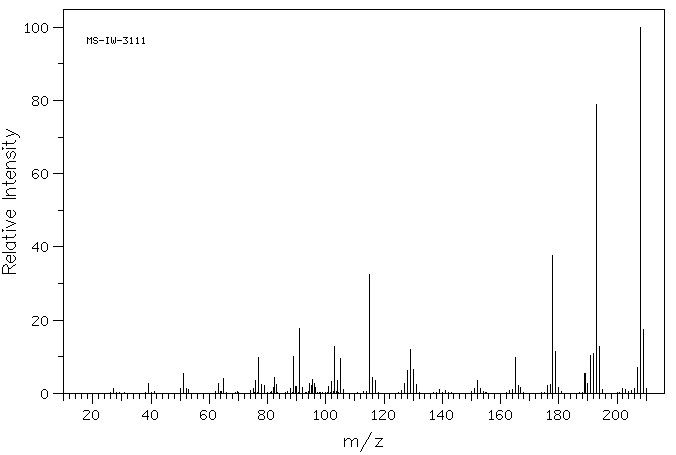(E)-2,3-diphenylbutene | 782-06-9
中文名称
——
中文别名
——
英文名称
(E)-2,3-diphenylbutene
英文别名
(E)-2,3-diphenyl-2-butene;(E)-but-2-ene-2,3-diyldibenzene;[(E)-3-phenylbut-2-en-2-yl]benzene
CAS
782-06-9
化学式
C16H16
mdl
——
分子量
208.303
InChiKey
ATYQGOFMEQUNMJ-BUHFOSPRSA-N
BEILSTEIN
——
EINECS
——
-
物化性质
-
计算性质
-
ADMET
-
安全信息
-
SDS
-
制备方法与用途
-
上下游信息
-
文献信息
-
表征谱图
-
同类化合物
-
相关功能分类
-
相关结构分类
物化性质
-
熔点:107°C
-
沸点:307.51°C (estimate)
-
密度:0.9870
计算性质
-
辛醇/水分配系数(LogP):5.4
-
重原子数:16
-
可旋转键数:2
-
环数:2.0
-
sp3杂化的碳原子比例:0.12
-
拓扑面积:0
-
氢给体数:0
-
氢受体数:0
上下游信息
-
上游原料
中文名称 英文名称 CAS号 化学式 分子量 —— (Z)-2,3-diphenyl-2-butene 782-05-8 C16H16 208.303 —— (E)-2,3-bis(2-bromophenyl)-2-butene 123994-14-9 C16H14Br2 366.095 2-苯基-1-丙烯 isopropenylbenzene 98-83-9 C9H10 118.178 -
下游产品
中文名称 英文名称 CAS号 化学式 分子量 —— (Z)-2,3-diphenyl-2-butene 782-05-8 C16H16 208.303 (1,4-二溴-3-苯基丁-2-烯-2-基)苯 1,4-dibromo-2,3-diphenyl-2-butene 7781-70-6 C16H14Br2 366.095 —— (E)-1,4-dibromo-2,3-diphenyl-2-butene 34804-71-2 C16H14Br2 366.095
反应信息
-
作为反应物:描述:参考文献:名称:四氧化锇促进的烯烃催化氧化裂解:有机金属臭氧分解摘要:提出了一种温和的有机金属替代臭氧分解利用 oxone 和 OsO(4)。这是烯烃的直接氧化,通过 oxone 的作用通过锇酸酯的碳-碳裂解。二十四种不同的烯烃以高产率 (>80%) 转化为其相应的酮或羧酸。游离醇、乙酸酯和苄基保护的醇以及 1,2-二醇在这些条件下是稳定的。该方法适用于传统的有机合成。DOI:10.1021/ja017295g
-
作为产物:参考文献:名称:Roth, Wolfgang R.; Staemmler, Volker; Neumann, Martin, Liebigs Annalen, 1995, # 6, p. 1061 - 1118摘要:DOI:
文献信息
-
Comportement des organomagnesiens vis-a-vis de composes acetyleniques disubstitues en presence de PdCl2作者:C. Broquet、H. RiviereDOI:10.1016/s0022-328x(00)83386-0日期:1982.2In the presence of HMPT as a cosolvent, uncomplexed PdCl2 can be used in addition reactions of reducing or non-reducing Grignard reagents with disubstituted acetylenic compounds. Stereospecific conjugated dienes are obtained in good yields together with dialkylation and reduction products.
-
Copper-Catalyzed Aerobic Oxidative Transformation of Ketone-Derived<i>N</i>-Tosyl Hydrazones: An Entry to Alkynes作者:Xianwei Li、Xiaohang Liu、Huoji Chen、Wanqing Wu、Chaorong Qi、Huanfeng JiangDOI:10.1002/anie.201405058日期:2014.12.22A novel strategy involving Cu‐catalyzed oxidative transformation of ketone‐derived hydrazone moiety to various synthetic valuable internal alkynes and diynes has been developed. This method features inexpensive metal catalyst, green oxidant, good functional group tolerance, high regioselectivity and readily available starting materials. Oxidative deprotonation reactions were carried out to form internal
-
Reductive coupling of carbonyl compounds promoted by cobalt or titanium nanoparticles作者:Fabiana Nador、Evangelina Mascaró、Melisa Castro、Cristian Vitale、Gabriel RadivoyDOI:10.3998/ark.5550190.0012.726日期:——with readily prepared cobalt or titanium nanoparticles, under mild reaction conditions, led to the obtention of different reductive dimerization products depending on the nature of the transition metal used. Cobalt nanoparticles (CoNPs) allowed the selective transformation of the starting carbonyl compounds into vicinal diols, whereas the reaction promoted by titanium nanoparticles (TiNPs) led to the
-
Weakening C−O Bonds: Ti(III), a New Reagent for Alcohol Deoxygenation and Carbonyl Coupling Olefination作者:Horacio R. Diéguez、Armando López、Victoriano Domingo、Jesús F. Arteaga、José A. Dobado、M. Mar Herrador、José F. Quílez del Moral、Alejandro F. BarreroDOI:10.1021/ja906083c日期:2010.1.13Investigations detailed herein, including density functional theory (DFT) calculations, demonstrate that the formation of either alkoxy- or hydroxy-Ti(III) complexes considerably decreases the energy of activation for C-O bond homolysis. As a consequence of this observation, we described two new synthetic applications of Nugent's reagent in organic chemistry. The first of these applications is an one-step本文详述的研究,包括密度泛函理论 (DFT) 计算,表明烷氧基或羟基 Ti(III) 络合物的形成显着降低了 CO 键均裂的活化能。作为这一观察结果的结果,我们描述了 Nugent 试剂在有机化学中的两个新的合成应用。这些应用中的第一个是对醇(包括苄醇和烯丙醇以及 1,2-二羟基化合物)进行脱氧还原的一步法。此外,我们还证明了 Ti(III) 能够介导羰基偶联-烯化。从这个意义上说,尽管 35 多年来,人们普遍认为 Ti(II) 或 Ti(0) 是 McMurry 反应还原过程中的活性物质,所提供的机械证据证明了 Ti(III) 频哪醇参与本文所述的 Nugent 试剂介导的 McMurry 烯化的脱氧步骤。这一观察结果揭示了有机化学中可能是机械上更复杂的转变之一。最后,我们还证明了这两个过程都可以在 Cp(2)TiCl(2) 中通过使用三甲基氯硅烷 (TMSCl) 作为最终的氧气捕集器进行催化。
-
InCl<sub>3</sub>-Zn. A Novel Reduction System for the Deoxygenative Coupling of Carbonyl Compounds to Olefins作者:Dhiren C. Barman、Ashim J. Thakur、Dipak Prajapati、Jagir S. SandhuDOI:10.1055/s-2001-12326日期:——A simple and inexpensive procedure for the deoxygenative homo-coupling and cross-coupling of carbonyl compounds with InCl3-Zn system in dry acetonitrile at ambient pressure is achieved. The procedure gives excellent yields of E-olefinic products.在干燥乙腈中,采用InCl3-Zn体系,在常压下实现了一种简单且成本低廉的羰基化合物的去氧同偶联和交叉偶联过程。该方法能够高效地获得E-烯烃产物。
表征谱图
-
氢谱1HNMR
-
质谱MS
-
碳谱13CNMR
-
红外IR
-
拉曼Raman
-
峰位数据
-
峰位匹配
-
表征信息
同类化合物
(E,Z)-他莫昔芬N-β-D-葡糖醛酸
(E/Z)-他莫昔芬-d5
(4S,5R)-4,5-二苯基-1,2,3-恶噻唑烷-2,2-二氧化物-3-羧酸叔丁酯
(4S,4''S,5R,5''R)-2,2''-(1-甲基亚乙基)双[4,5-二氢-4,5-二苯基恶唑]
(4R,5S)-4,5-二苯基-1,2,3-恶噻唑烷-2,2-二氧化物-3-羧酸叔丁酯
(4R,4''R,5S,5''S)-2,2''-(1-甲基亚乙基)双[4,5-二氢-4,5-二苯基恶唑]
(1R,2R)-2-(二苯基膦基)-1,2-二苯基乙胺
鼓槌石斛素
黄子囊素
高黄绿酸
顺式白藜芦醇三甲醚
顺式白藜芦醇
顺式己烯雌酚
顺式-白藜芦醇3-O-beta-D-葡糖苷酸
顺式-桑皮苷A
顺式-曲札芪苷
顺式-二苯乙烯
顺式-beta-羟基他莫昔芬
顺式-a-羟基他莫昔芬
顺式-3,4',5-三甲氧基-3'-羟基二苯乙烯
顺式-1-(3-甲基-2-萘基)-2-(2-萘基)乙烯
顺式-1,2-双(三甲基硅氧基)-1,2-双(4-溴苯基)环丙烷
顺式-1,2-二苯基环丁烷
顺-均二苯乙烯硼酸二乙醇胺酯
顺-4-硝基二苯乙烯
顺-1-异丙基-2,3-二苯基氮丙啶
非洲李(PRUNUSAFRICANA)树皮提取物
阿非昔芬
阿里可拉唑
阿那曲唑二聚体
阿托伐他汀环氧四氢呋喃
阿托伐他汀环氧乙烷杂质
阿托伐他汀环(氟苯基)钠盐杂质
阿托伐他汀环(氟苯基)烯丙基酯
阿托伐他汀杂质D
阿托伐他汀杂质94
阿托伐他汀杂质7
阿托伐他汀杂质5
阿托伐他汀内酰胺钠盐杂质
阿托伐他汀中间体M4
阿奈库碘铵
锌(II)(苯甲醛)(四苯基卟啉)
银松素
铜酸盐(5-),[m-[2-[2-[1-[4-[2-[4-[[4-[[4-[2-[4-[4-[2-[2-(羧基-kO)苯基]二氮烯基-kN1]-4,5-二氢-3-甲基-5-(羰基-kO)-1H-吡唑-1-基]-2-硫代苯基]乙烯基]-3-硫代苯基]氨基]-6-(苯基氨基)-1,3,5-三嗪-2-基]氨基]-2-硫代苯基]乙烯基]-3-硫代
铒(III) 离子载体 I
铀,二(二苯基甲酮)四碘-
钾钠2,2'-[(E)-1,2-乙烯二基]二[5-({4-苯胺基-6-[(2-羟基乙基)氨基]-1,3,5-三嗪-2-基}氨基)苯磺酸酯](1:1:1)
钠{4-[氧代(苯基)乙酰基]苯基}甲烷磺酸酯
钠;[2-甲氧基-5-[2-(3,4,5-三甲氧基苯基)乙基]苯基]硫酸盐
钠4-氨基二苯乙烯-2-磺酸酯








